Relative stability and reducibility of CeO2 and Rh/CeO2 species on the surface and in the cavities of γ-Al2O3: a periodic DFT study†
Abstract
We report the structure and stability of ceria units deposited on the surface of γ-Al2O3 or incorporated in its cavities, as determined by periodic density functional calculations. Ceria species are modeled as CeO2 or Ce2O4 moieties or as a small nanoparticle, Ce13O26, on the (100) and (001) surfaces of a γ-Al2O3 slab. Among the studied structures the incorporation of Ce4+ ions in cavities of γ-Al2O3 is favored with respect to the ions on the surface only in subsurface cavities of the (100) surface. The calculations also suggested that formation of a surface layer of ceria on the (100) alumina surface is preferable compared to three-dimensional moieties. The deposition of a small ceria nanoparticle on (100) and (001) surfaces of γ-Al2O3 reduces the energy for oxygen vacancy formation to an essentially spontaneous process on the (100) surface, which may be the reason for the experimentally detected large fraction of Ce3+ ions in the CeO2/γ-Al2O3 systems. The deposition of a single rhodium atom or RhO unit in some of the structures with a CeO2 unit and Ce13O26 showed that spontaneous electron transfer from rhodium to cerium ion occurs, which results in reduction of Ce4+ to Ce3+ and the oxidation of rhodium. Only in the presence of deposited rhodium atoms, the incorporated cerium ions can be reduced to Ce3+.


 Please wait while we load your content...
Please wait while we load your content...